She wants to know what drives variation in flowers
Researcher profile
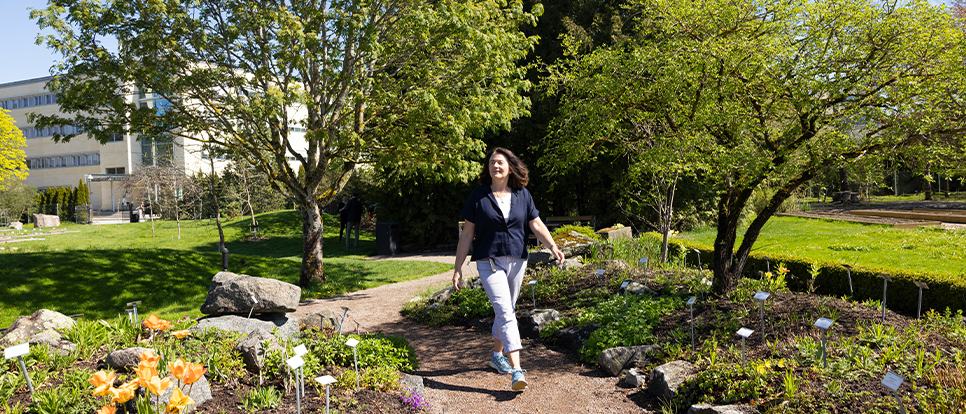
The Botanical Garden is an inspiration to plant ecologist Nina Sletvold, who prefers bell-shaped flowers in her own garden: “Being able to hear bumblebees buzzing inside these flowers is such a defining sound of summer for me.” Photo: Mikael Wallerstedt
It can seem like there is an immense variation in colours, shapes and scents among flowers. But plant ecologist Nina Sletvold hopes she can contribute new insights into plant diversity and evolution by studying their interaction with pollinators.“I’m driven by a desire to understand how plant diversity has arisen, and how our ecosystems can remain robust as they face future climate change,” she says.
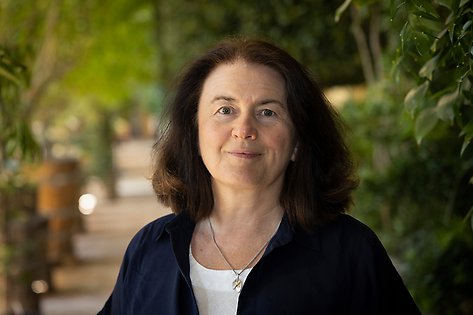
Nina Sletvold, Professor of Biology. Photo: Mikael Wallerstedt
The Botanical Garden at Uppsala University is bathed in May sunshine and a number of flower beds are already boasting a colourful crop of flowers. Down from the Tropical Greenhouse is an artwork: the Family Tree of Flowering Plants.
“It’s an installation of leaf-shaped flower beds that shows how plants are related in families,” says Nina Sletvold. “And an illustration of the tree of life, how different groups of species branch out and diversity arises.”
But the species group that is the main focus of her research at the Evolutionary Biology Centre – orchids – isn’t part of this installation. The orchid species in the Botanical Garden are usually grown indoors, in the Tropical Greenhouse. However, several of the species she studies, such as the Elder-flowered orchid, is already in full bloom in its natural environment, closely followed by the Fragrant orchid. But this particular spring, Nina Sletvold is staying in Uppsala, as her research group is about to start a new experiment in the Botanical Garden, using experimental evolution.
“So we’re not going to use orchids, as their life cycles are too slow. Instead, we will study Rock cress (Arabidopsis lyrata, eds note) which is easier to cultivate. We want to see how the expression of the flower’s characteristics changes over several generations in response to difference in pollination intensity.”
Pollination by hand
To determine which environmental factors are important for the development of the flower’s characteristics in natural populations, researchers can manipulate the plants’ environment. One way is to reduce pollination, for example by placing a net over the plant. This is the method used for Rock cress in the Botanical Garden. Another way is to increase pollination by adding pollen by hand to all the flowers on the plant. The researchers can then compare a group of openly pollinated plants and a group of hand-pollinated plants to understand the contribution that pollinators make to reproductive success.
“All the differences one sees in the connections between flower characteristics and seed production are then due to the work of pollinators! For example, one hypothesis might be that plants with many flowers get more visits from pollinators, and thus produce more seeds. But if we were to find the same connection between the number of flowers and the plant’s seed production when we have hand-pollinated them, the reason might instead be that plants with many flowers are larger and very efficient at absorbing resources. In that case, it’s not pollinators that are responsible for the number of flowers.”
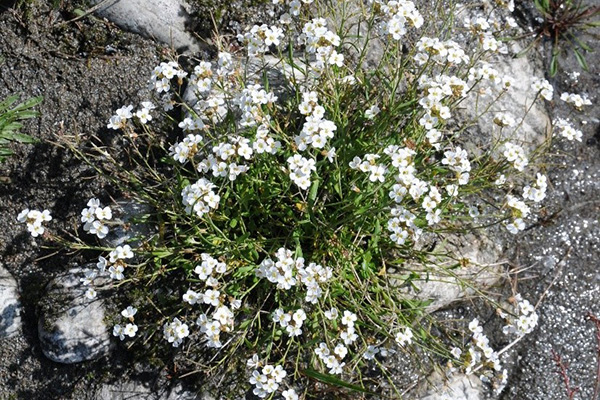
Nina Sletvold’s research group will be conducting a new experiment to analyse the paternity of the plant species Cardaminopsis petraea or Rock cress. Photo: Nina Sletvold
Other factors underlying the evolution of flowers include access to water and interactions with herbivores. But according to Nina Sletvold, the role of pollinators is still crucial. So when the habitats of wild bees, bumblebees, butterflies, moths, beetles and other insects change, this has an impact on plant pollination and thus the plants’ fertilisation success. This is apparent from how many seeds are formed, and therefore evident in population growth, as well as how flower characteristics develop.
In short, it is the interaction with pollinators, and how this interaction is influenced by other environmental factors, that could explain why flowers are so diverse in their shape, colour and scent, explains Nina Sletvold.
“Poor pollination can lead to natural selection because plants might ‘compensate’ by, for example, producing many large flowers or a strong scent to attract pollinators. That said, many plants can pollinate themselves, so reduced pollination can lead to the development of selfing, a self-fertilising mating system.”
Early interest in the natural world
In her childhood, Nina Sletvold was interested in not only plants but animals, and nature in general. She grew up in a family that spent a lot of time outdoors in the woods and fields, which led to her becoming involved in nature conservation quite early.
“We lived down by the Trondheim Fjord, so it was natural to watch the birds along the shoreline. And the plants. I remember seeing my mother’s old herbarium from school with pressed plants, like they used to do in schools. I was very inspired by it and wanted to make one myself, which I did too.”
But becoming a biologist was not an obvious choice. After completing the natural science programme in upper secondary school, she started studying to become a pharmacist in Oslo. But while taking the first-year course in cell biology, she discovered that biology was much more interesting than chemistry.
“So I went in that direction – especially because I could do fieldwork and be outdoors.”
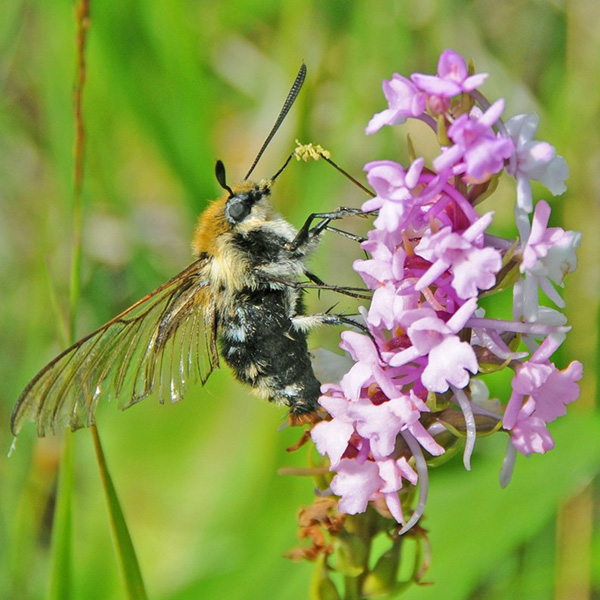
Fragrant orchid flowers (Gymnadenia conopsea ) being pollinated by the narrow-bordered bee hawk-moth (Hemaris tityus). Photo: Nina Sletvold
Today she has many years of field studies behind her from her time at university in Oslo, and later on mainly on Öland and Gotland. Among orchids, she has become particularly interested in the Fragrant orchid, a perennial herb with pink flowers. This was purely by chance, as it was part of a Norwegian monitoring programme. And as it turned out, many of this species’ characteristics are particularly well-suited to experiments.
“Most orchids are easy to hand-pollinate, including the Fragrant orchid. You can fish out pollinia from one flower and use them to pollinate another just by using a cocktail stick, toothpick or pen tip. The Fragrant orchid is also common enough to be able to do large field experiments. And it has many different pollinators, such as butterflies that are active during the day and moths at night, and hawk moths.”
Management increasingly important
Another research method for understanding variations in survival, growth and flowering is to compare populations over time and space. This can reveal connections between demographics and climate differences, for example.
“That allows us to see if the variation in survival is linked to summer drought, or if the flowering is boosted by a warm or humid spring. In one of our experiments in Norway, we’re studying how management affects plant demographics by following individual fragrant orchid plants and other species in fields mown by scythe, and comparing them to individuals in fields where no management has been done. There, increased temperature seems to be positive for the growth of the Fragrant orchid. On the other hand, the fields need to be mown more often, as higher temperatures increase competition from other species.
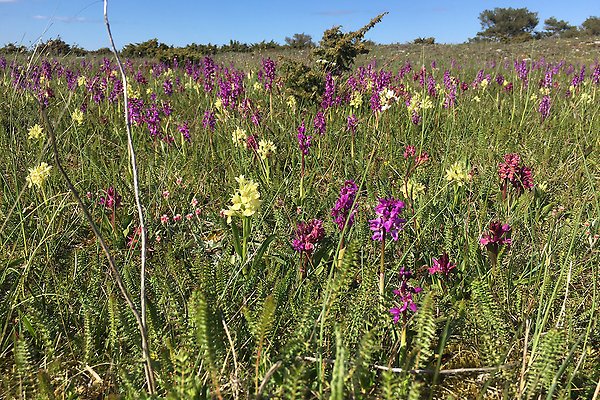
The Elder-flowered orchid (Dactylorhiza sambucina) in yellow and burgundy, is one of Nina Sletvold’s study species – in the picture together with the keys of St Peter (Orchis mascula) on Stora Karlsö. Photo: Nina Sletvold
But at Alvaret on Öland, the situation is reversed. There, drought seems to have negative consequences and leads to a rapid decline in the Fragrant orchid.
“Many of today’s orchid populations are already in decline and are dependent on management measures. This shows that a future climate may require changes in management systems.”
Action programmes for individual species
If Nina Sletvold could have her wish, the knowledge and results that she and other researchers produce would be used to develop action programmes for individual species and to update management plans based on changes in the climate. Several of the systems she is studying are linked to grasslands and Natura 2000 sites that have conservation and management plans in place.
“It’s also about understanding evolution and incorporating evolutionary thinking into nature management. There is an increasing focus on restoring nature, and we need to understand how best we can do this. But one thing is quite clear: it’s easier to take care of the nature we have than to try to recreate it through restoration measures. So I wish there was a greater willingness to protect biodiversity and species diversity in the first place.”
Anneli Björkman
Facts: Nina Sletvold
Title: Professor of Biology, specialising in plant ecology
Family: Partner and two adult daughters in Norway
Hobbies: In the summer I do a lot of gardening, and in the winter I plan new projects by browsing through seed catalogues and watching British gardening programs in particular.
Reads: Everything from The Odyssey to modern Norwegian novels.
Memorable travels: Peru from the Andes down to the Amazon and many tours of the Mediterranean. But I also like to travel in Scandinavia, mainly Norway, going on mountain hikes and experiencing areas I haven’t seen before.
If I wasn’t a researcher: I love working with the soil so probably a farmer or a master gardener.
